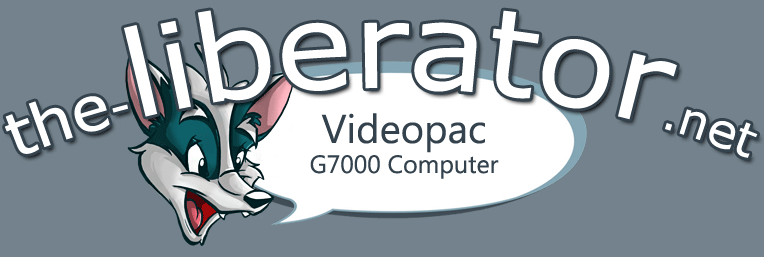

8-bit Personal Computer - Dismantled for reference and curiosity
After the merger of Magnavox and Philips in 1974, Philips released the Philips Videopac Computer G7000 to the European market in 1978. The G7000 is essentially identical in function and form to the Magnovox Odyssey2 that was sold in the United States. The main differences, bar the NTSC / PAL variation are cosmetic. The G7000 doesn't have the big, red power button on the upper face and the action buttons are black not red.
This was a brave foray into the game market bringing both a cartridge based system and a home computer to a table already crowded with Atari 2600s. Atari had released their 2600 a year earlier but it wasn't natively a home computer and in this the G7000 appealed to consumers.
Most memorable about the G7000, bar the cartridges having big pull handles are the interactive board game titles such as 'The Great Wall Street Fortune Hunt', 'Conquest of the World' and what is by far the best title, 'Quest for the Rings'; a very Lord of the Rings-esque/Dungeons & Dragons romp. These games shipped in large boxes and come with plastic counters and overlays that can be placed over the G7000's membrane keyboard to customise it to that specific game. The titles are amazingly well developed and years before their time. They were marketed as the 'Master Strategy Series' and the only contemporary comparison would be the VHS and DVD TV games popular in the late 80s and 90s; that are extremely limited in contrast.
Unfortunately the large, membrane keyboard (visually customer engaging at the time) is horrible to type on and hardly ever used other than for a few educational titles and for selecting games. A cartridge titled 'Computer Intro!' was released to ease new enthusiasts into programming and you can write your own programs (slowly) in BASIC or machine code. Almost anyone who tried would agree that it wasn't a pleasant experience. Out of the box, there was no way to save the programs you've written until the release of add-on hardware later.
Adding to this mixed bag, the G7000 had great joysticks for the day and marketers they didn't miss a chance to advertise the fact. They were good, eight directional, self centering and required very little force to move the stick to its maximum point of travel. This was advertised as quite a selling point with the compared to the Atari 2600 joysticks that are comparatively quite stiff.
The G7000 has okay, single channel sound and users could buy an expansion module called 'The Voice' that added surprisingly good sound capabilities and very capable speech synthesis.
Graphically the G7000 was inferior to the Atari 2600 and later to the Intellivision, however to its credit, the characters on screen moved more smoothly than other consoles. So the experience was slightly more boxy graphics with more natural movement making the G7000 seem more capable.
*
There were a number of add-on hardware modules released for the G7000. As mentioned above 'The Voice' is a physically huge sound and speech component that sits over the whole top and cartridge port section. There is also a chess module that incorporates a cartridge cabled to a black box that in turn sits on top of the full length of the G7000 called the C7010. It basically adds additional CPU and memory to the G7000 that natively doesn't have enough grunt to play a worthwhile game of chess on its own.
In 1983 the 'Home Computer Module C7420' was released and like the C7010 sits across the top of the Videopac G7000. This adds a much needed CPU and memory boost and above all it gives users the ability to save and load programs to most standard cassette recorders. It came loaded with Microsoft BASIC, upgraded the G7000's 160 X 200 resolution to 320 x 240 pixels and provided numerous other features and performance upgrades.
A lesser known add-on is the 'VU-0011 Modulateur SECAM' that allowed the G7000 to output to SECAM.
Philips later released a number of different versions of the G7000 all with different hardware to entice buyers. Units in this series are the G7000, G7200, G7400, G7401 and the N60. Some came as a combo CRT screen/keyboard/computer all in one shell.
Side note: I must apologise for the poor photographs of this one.